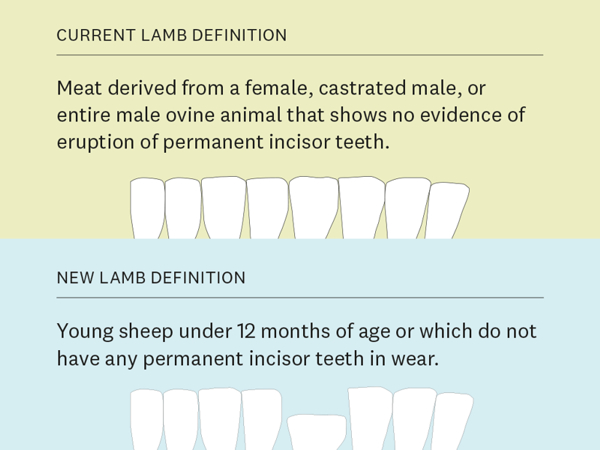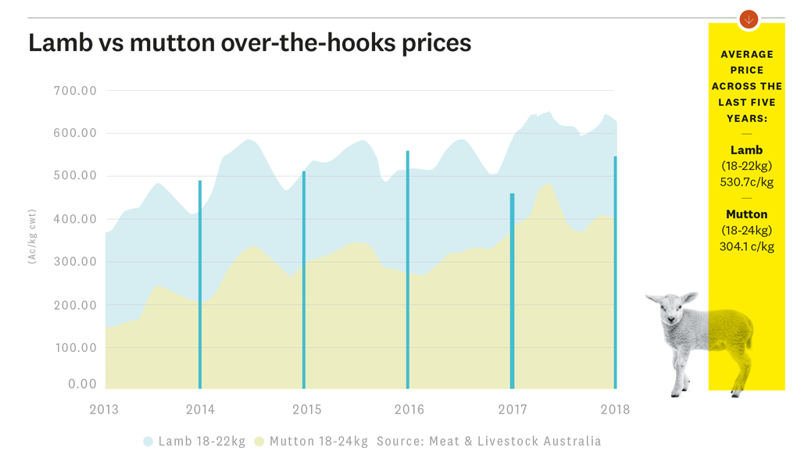THE idea of mutton dressed as lamb is embedded in Australian society. And with it comes negative connotations associated with taste and quality.
But industry’s peak body, Sheep Producers Australia (SPA), has recently endorsed a change in the industry definition of lamb to bring it in line with our biggest competitor, New Zealand. It doesn’t mean, however, that consumers will now be eating mutton, rather than lamb.
Under current classifications, as soon as a lamb loses a baby tooth, and a permanent tooth starts to come through, it is defined as hogget or mutton – although hogget is a term used mostly on-farm and isn’t employed when marketing sheepmeat.
SPA says that under the current system, if any teeth in the lamb erupt, the animal is re-categorised to mutton, which results in a price discount, known as the “price cliff face”. The new definition, to harmonise with that of New Zealand, is outlined as “young sheep under 12 months of age or which do not have any permanent incisor teeth in wear”.
SPA says the decision was based on data, and in the nine-week public consultation, 83% of industry survey respondents supported the change in definition.
It’s no surprise that lamb is the preferred sheepmeat for Australians, with per capita lamb consumption at about 9kg per person. This makes us one of the largest consumers in the world.
So what will the new definition mean at the dining table? Allan Piggott, SPA president, says advice from the consumer markets insight unit at Meat & Livestock Australia (MLA), suggests no anticipated change to eating quality of the product and the chance of a detrimental effect on consumer preference is low.
Agricultural consultancy Holmes Sackett was commissioned by SPA to assess the implications of changing the definition. In its summary of the public consultation, it reports that those in favour in the change of definition felt that.
“New Zealand has access to all important markets with its existing definition, and therefore there should be no issues with market access if Australia were to change to a definition that was the same as New Zealand’s”.
NSW Farmers’ livestock policy director, Annabel Johnson, says although the Association supported retaining the existing lamb definition, it is focused on ensuring that the implementation of the new definition is seamless.
“NSW Farmers will work closely with SPA to ensure all the potential ramifications are well-understood and appropriately managed through the implementation process,” Annabel says.
The Association will encourage the sheepmeat industry to focus on enhancing the integrity of lamb products through developing a cuts-based value system for lamb, including a sheepmeat eating quality grading system.
“The cattle industry has recently been through a thorough review to modernise and move the industry towards focusing on eating quality outcomes, and a similar outcome is needed in the sheep industry,” Annabel says.
“By developing a cuts system based on eating quality, and encouraging producers to sign up to Meat Standards Australia, we can leverage the full value from the whole animal and meet consumer expectations.”
THE PRICE OF TEETH
Australian Meat Industry Council CEO Patrick Hutchinson says the new definition will ensure those lambs which have one tooth erupt, just prior to sale or on the way, aren’t moved to the mutton category.
|
 |
|
Ryan Watson of The Fairlight Butcher doing what he loves.
|
“Currently, you can have lambs in the same cohort, side-by-side, one has its milk teeth and the other has two permanent teeth erupting, and the one with permanent teeth is determined as being mutton and not being as good eating quality,” Patrick says.
“We are talking about changing an anomaly and having product in the market which is accurately described for what it is, which is lamb.”
Ryan Watson, owner of The Fairlight Butcher in Sydney, believes the small change in the lamb definition won’t affect the taste or quality of the meat, providing it isn’t coming off a four-tooth sheep.
Ryan says consumers just assume what they are buying is all lamb – which it is, considering 95% of mutton produced in Australia is exported.
“The only people who ask for mutton or hogget are European consumers, or those who grew up on a farm,” he says.
“Most customers are more concerned with how the animal is raised. If it is grass-fed and slaughtered humanely, they don’t talk about age.”
Ryan believes once the definition of lamb is changed, consumers will need to be educated about it and know it won’t affect price, flavour or tenderness.
Sheep producer and NSW Farmers’ Sheepmeat Committee chair, Ian Cargill, from Braidwood, says Australian lamb has a good brand which has been “hard fought for and I don’t want that to change”.
He says the development of an eating quality system will deliver far greater returns to sheep producers than the current lamb definition change.

“Sheep producers in NSW produce a premium product and moving to a cuts-based eating quality system will ensure that their product’s value is more accurately recognised.”
However, he can also see price positives for reclassifying lamb in some production systems, as currently “a $130 to $140 lamb could end up being sold as $80 to $90 mutton”.
The next step for SPA and industry stakeholders is to work through the development of an implementation plan, given the lamb definition is currently defined in various federal, state and industry regulations and standards. NSW Farmers will be working with industry to get implementation right.

Lamb pricing has consistently held a premium over mutton. Meat & Livestock Australia’s market intelligence manager, Scott Tolmie, says that over the last five years, lamb over-the-hooks prices have had an average premium of 226c/kg carcass weight (cwt) over mutton, with lamb (18-22kg) averaging 531c/kg cwt and mutton (18-24kg) averaging 304c/kg cwt.
“These premiums have historically been quite consistent and generally have fluctuated within 50c/kg cwt either side
of the average throughout this time,”
Scott says.
“However, one key thing to note is that prices have increased significantly in both lamb and mutton in the last five years.”